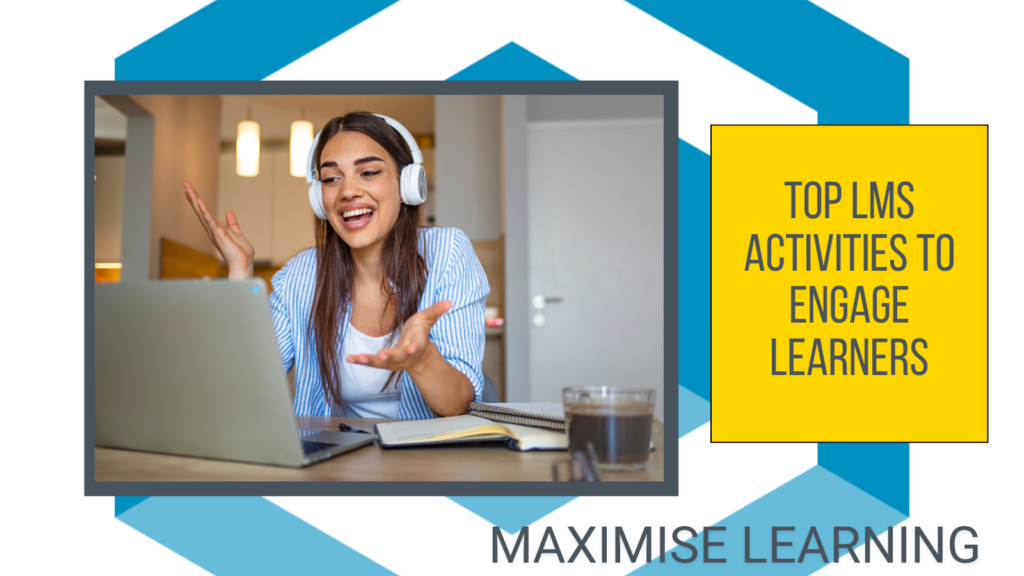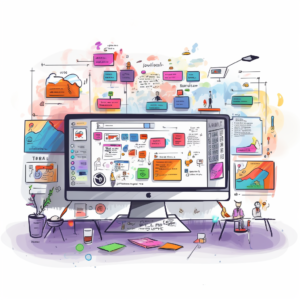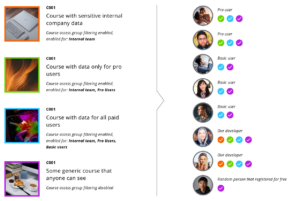In today’s digital learning era, engaging and interactive LMS activities are pivotal for educational success. This article delves into the various dynamic activities that can be integrated into an LMS to enhance the learning experience. From collaborative projects to the use of gamification and multimedia content, we explore strategies to make e-learning more interactive and effective.
Key Takeaways
- Interactive LMS Activities: Diverse activities, including collaborative projects and gamification, significantly enhance learner engagement.
- Personalized Learning: Tailoring learning paths to individual needs in LMS improves engagement and learning outcomes.
- Multimedia Integration: Incorporating videos, podcasts, and interactive media enriches the learning experience.
- Virtual Workshops/Webinars: Live, interactive sessions in LMS provide real-time learning and foster deeper understanding.
- Discussion Forums and Peer Feedback: These platforms encourage critical thinking and effective communication among learners.
Table of Contents
An LMS is not just a content repository; it’s a multifaceted platform where learning is curated, tracked, and optimized. The importance of integrating engaging activities within an LMS cannot be overstated. They foster a more profound connection with the material, promote active learning, and cater to diverse learning styles. By leveraging the full spectrum of LMS capabilities, educators can create a learning environment that is not only informative but also captivating and conducive to deeper understanding.
Collaborative Projects and Team Assignments
Collaborative projects and team assignments stand at the forefront of enriching LMS activities. These ventures go beyond mere academic exercises; they are crucibles for skill-building, fostering teamwork, and nurturing communication skills. Integrating these activities within an LMS framework seamlessly blends technological efficiency with collaborative learning.
Integrating Team Assignments in LMS: The first step is designing assignments that align with learning objectives while promoting teamwork. LMS platforms typically offer tools to create groups, assign roles, and facilitate interaction. Educators can set up virtual workspaces within the LMS, where teams can brainstorm, share resources, and track their progress. The integration process involves setting clear guidelines, deadlines, and criteria for assessment, ensuring that the collaborative effort is focused and productive.
Enhancing Interaction: Modern LMS platforms support various interactive elements like discussion boards, shared document editing, and real-time messaging. These tools mimic the dynamics of a physical classroom, allowing for spontaneous ideas and discussions. Additionally, incorporating file-sharing and collaborative tools like Google Docs or Microsoft Teams within the LMS can streamline the collaboration process.
Evaluating Contributions: A significant aspect of collaborative projects in an LMS is the ability to monitor and assess individual contributions. This can be achieved through tools that track participation, contributions to discussions, and individual inputs in group tasks—such analytics help provide fair, individualized feedback.
Benefits of Collaborative Learning:
- Enhanced Problem-Solving Skills: Collaborative projects encourage students to approach problems from different angles, promoting a more comprehensive understanding.
- Improved Communication Skills: Regular interaction within groups hones communication skills, an essential attribute in the professional world.
- Development of Teamwork Abilities: Working in groups teaches students the value of teamwork and collective effort.
- Exposure to Diverse Perspectives: Collaborative learning exposes students to various viewpoints, enriching their learning experience.
- Increased Engagement and Motivation: Group activities often lead to increased engagement, as students feel a sense of belonging and responsibility towards their team.
Collaborative projects and team assignments within an LMS are not just educational tools; they are vital in preparing students for the collaborative nature of the modern workplace, making them an indispensable part of contemporary e-learning strategies.
Gamification Elements
Gamification is a transformative approach that injects play elements into the learning process, making education both engaging and enjoyable. This innovative strategy leverages the innate human love for games to enhance student motivation and participation. By integrating game mechanics into the curriculum, learners are not just passively absorbing information but actively engaging with it in a fun and interactive manner.
Examples of Gamification Elements:
- Badges: These are digital rewards for achieving specific milestones or mastering particular skills within the course. Badges act as tangible symbols of accomplishment, motivating learners to strive for more.
- Leaderboards: They foster a healthy competitive environment, showcasing top performers based on various criteria like quiz scores, assignments, or participation. Leaderboards tap into the competitive spirit, driving learners to engage more deeply with the material.
- Points and Levels: Accumulating points for completing tasks or participating in activities and progressing through different levels keeps learners motivated and gives them a sense of progression.
- Interactive Challenges: These are short, game-like activities embedded within the course material, making learning more interactive and less monotonous.

Effectiveness in Learner Engagement:
Gamification enhances engagement by providing a compelling narrative that drives the learning journey. It taps into the natural human desires for achievement, competition, and recognition. This approach has been shown to increase retention rates, as the interactive and fun nature of gamified learning makes the material more memorable. Moreover, it caters to various learning styles, particularly for those who thrive in interactive and dynamic learning environments.
Discussion Forums and Peer Feedback
Discussion forums and peer feedback are vital components of an interactive LMS, offering spaces for collaboration, reflection, and critical thinking.
Setting Up and Managing Discussion Forums:
Creating discussion forums in an LMS involves not just the technical setup but also establishing clear guidelines and objectives. Forums should be organized around specific topics or modules, allowing learners to focus their discussions. Moderation is key; educators should monitor conversations to ensure they remain productive and respectful. Additionally, integrating multimedia elements like videos or infographics can stimulate more dynamic discussions.
Best Practices for Peer Feedback:
- Constructive Feedback: Encourage learners to provide feedback that is specific, actionable, and kind.
- Guided Responses: Provide templates or guidelines for feedback to ensure it’s comprehensive and focused.
- Regular Participation: Regularly contribute to forums and feedback sessions as part of the course requirements.
Advantages of Peer-to-Peer Interaction:
- Enhanced Understanding: Explaining concepts to peers and engaging in discussions can deepen understanding of the material.
- Diverse Perspectives: Learners are exposed to different viewpoints, enriching the learning experience.
- Social Learning: Interaction with peers promotes a sense of community and belonging, which can enhance motivation and engagement.
- Critical Thinking Skills: Engaging in thoughtful discussions and critiques develops critical thinking and analytical skills.
Incorporating discussion forums and peer feedback in an LMS not only enriches the learning experience but also prepares students for real-world scenarios where collaboration and constructive criticism are key to personal and professional growth.
Multimedia Content Integration
Integrating multimedia content significantly elevates the learning experience. This approach involves blending traditional text-based materials with dynamic media, such as videos, podcasts, and interactive modules, creating a rich and varied learning environment.
Incorporating Diverse Media Types:
- Videos: Short, engaging instructional videos can clarify complex topics and add a visual dimension to learning.
- Podcasts: These are excellent for delivering content in an audio format, ideal for learning on the go.
- Interactive Media: Interactive simulations, quizzes, and games make learning more engaging and hands-on.
Tools and Techniques for Multimedia Integration:
- Utilize LMS features that support embedding or linking multimedia content directly into course materials.
- Employ authoring tools like Adobe Captivate or Articulate Storyline for creating custom interactive content.
- Ensure content is mobile-friendly and accessible across various devices, considering the increasing use of smartphones for e-learning.
Enhancing Learning Experience:
Multimedia content caters to different learning styles – visual, auditory, and kinesthetic – making it a versatile tool for addressing the diverse needs of learners. It breaks the monotony of text-heavy courses, keeps learners engaged, and can simplify complex concepts through visual representation. Furthermore, it supports the principle of microlearning – delivering content in small, manageable chunks that are easier to absorb and retain.
Virtual Workshops and Webinars
Virtual workshops and webinars are critical components of an interactive LMS, offering real-time, collaborative learning experiences. These live sessions bridge the gap between traditional classroom settings and digital learning environments.
Organizing Live Virtual Sessions:
- Planning: Define clear objectives and outcomes for the session. Choose a suitable platform that integrates well with your LMS and supports interactive features like polls, Q&A, and breakout rooms.
- Promotion: Use the LMS’s communication tools to inform and remind learners about the upcoming session.
- Technical Setup: Ensure a stable internet connection, good quality audio/video equipment, and a backup plan in case of technical issues.
Engaging Learners Through Interactive Webinars:
- Interactive Elements: Utilize polls, live quizzes, and chat features to keep the audience engaged.
- Breakout Sessions: Small group discussions or activities during the webinar can foster deeper understanding and interaction.
- Guest Speakers: Inviting experts or industry professionals can add value and real-world relevance to the topic.
Benefits of Real-Time Learning Experiences:
- Immediate Feedback and Interaction: Live Q&A sessions and discussions provide instant feedback and clarification, enhancing understanding.
- Community Building: Webinars and workshops create a sense of community among learners, fostering connections and networking opportunities.
- Real-Time Application: Learners can apply concepts immediately through interactive exercises or discussions, reinforcing learning.
Virtual workshops and webinars in an LMS environment effectively replicate the interactivity and engagement of in-person training, making them a valuable tool in modern e-learning strategies.
Personalized Learning Paths
Personalized learning paths within an LMS are a paradigm shift from the one-size-fits-all approach, tailoring the educational journey to meet the unique needs of each learner. This customization is pivotal in maximizing the efficacy of the learning experience.
Creating Individual Learning Journeys:
- Utilize data-driven insights from learners’ past performances and preferences to create individualized learning paths.
- Allow learners to set goals and choose topics they are interested in, enhancing their engagement and motivation.
Adaptive Learning Technologies in LMS:
- Implement AI-driven adaptive learning technologies that automatically adjust the difficulty level of the content based on the learner’s performance.
- Use analytics to identify learning gaps and provide targeted resources to bridge these gaps.
Tailoring Content to Learner Needs:
- Offer a variety of content formats to cater to different learning styles, such as videos, readings, quizzes, and interactive simulations.
- Regularly update and adjust the learning paths based on feedback and performance data to ensure they remain relevant and effective.
Personalized learning paths empower learners to take charge of their education, providing a more engaging, relevant, and effective learning experience tailored to their individual needs and preferences.
Appsembler: Enhancing LMS Interactivity
Appsembler’s Tahoe LMS is a notable player in the realm of LMS, renowned for its ability to enhance interactivity and engagement in online learning environments. This platform stands out for its user-friendly interface and robust features designed to create a more dynamic and interactive e-learning experience.
Overview of Appsembler and its Features:
- Appsembler provides an intuitive platform that simplifies the creation and management of online courses.
- It supports a wide range of multimedia content, including videos, interactive quizzes, and simulations, making the learning experience more engaging.
- The platform offers extensive customization options, allowing educators to tailor the look and feel of their courses to match their branding or specific needs.
Supporting Interactive LMS Activities:
- Appsembler’s interactive tools, such as real-time quizzes and gamification elements, significantly increase learner engagement.
- The platform facilitates the creation of personalized learning paths, leveraging adaptive learning technologies to cater to individual learner needs.
- It seamlessly integrates with various third-party tools and plugins, enhancing the functionality and flexibility of the LMS.
Appsembler’s robust and versatile platform plays a crucial role in transforming traditional LMS into more engaging, interactive, and personalized learning environments, proving its efficacy in various educational and professional settings.
Conclusion
Looking ahead, the future of LMS is bright and promising. It’s poised to become more intuitive, responsive, and learner-centric. With advancements in AI and machine learning, LMS platforms will likely offer even more personalized learning experiences, adapting in real-time to the evolving needs of each learner.
The ongoing innovation in LMS activities is a testament to the ever-changing landscape of education, highlighting the importance of embracing these changes to foster a more engaging, effective, and inclusive learning environment.
Frequently Asked Questions
To enhance engagement in e-learning using an LMS, focus on incorporating interactive elements such as gamification, multimedia content, and collaborative activities. Gamification, through leaderboards and rewards, motivates learners by tapping into their competitive spirit. Integrating diverse multimedia elements like videos and podcasts caters to various learning styles, maintaining interest. Encourage collaboration with group projects and discussion forums, promoting peer interaction and a sense of community. Personalized learning paths tailored to individual learners’ needs and progress can also significantly boost engagement.
Virtual workshops in LMS-based learning are highly effective as they offer interactive, real-time learning experiences. They allow for immediate feedback and interaction, fostering a deeper understanding of the material. Virtual workshops facilitate active learning through discussions, group activities, and hands-on exercises. They also offer the flexibility of remote access while maintaining the benefits of a collaborative learning environment, making them a valuable tool in modern e-learning strategies.
Personalized learning paths in an LMS offer numerous benefits. They cater to individual learning styles and paces, ensuring that each learner is engaged and adequately challenged. By adapting content to suit individual needs and preferences, learners are more likely to stay motivated and invested in their learning journey. Personalized paths also allow for better tracking of progress and identification of specific areas where a learner may need additional support, leading to a more effective and efficient learning process.
Interactive quizzes are highly beneficial for e-learning. They provide immediate feedback, helping learners understand where they excel and where they need improvement. Quizzes can be used as learning tools themselves, reinforcing knowledge through repeated exposure to the material. They also add an element of interactivity and engagement to the learning process, breaking up the monotony of traditional learning methods and keeping learners more involved and interested in the course content.



